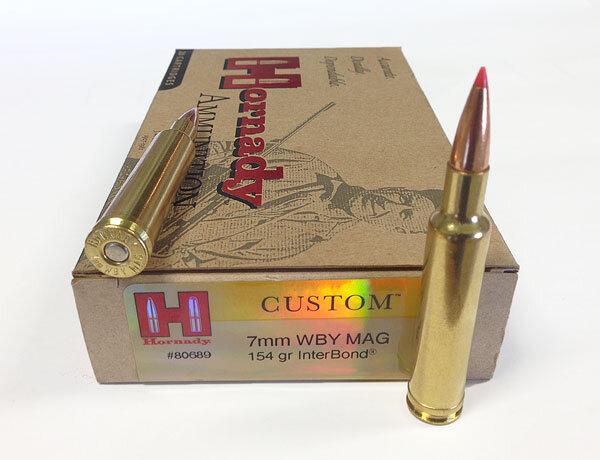7MM
Weatherby Magnum
There are all kinds of tales as to the mental framework of why shooters choose one cartridge over another. Back in the early 1960s, it was said that the 264 Winchester Magnum could barely compete with the beloved 270 Winchester, and that American hunters didn't like the metric designation. I don't know to this day whether most gun writers actually believe what they write, if they're writing to fulfill an editor's directive, or if they just don't know any better. The 264 is a big cartridge case launching a relatively small diameter bullet. The same case necked up to .338" for the 338 Winchester Magnum becomes much more efficient. However, the 338 Win Mag is not a contender at 1000 yards, whereas the 264 can be. Why did the 264 Winchester Magnum pretty much fail as a commercial round? Well, it had nothing to do with it being a metric designation. Absolutely nothing. It failed because Winchester managed to chamber it in the Model 70 Featherweight with its 22-inch barrel (as well as in the full-sized rifle), and then all of the written complaints regarding reduced muzzle velocity and increased muzzle blast were true. The 264 needs at least 26 inches of barrel. If the metric designation moans were true, Remington's 7mm Remington Magnum, with only 20-thousands more bullet diameter (0.020"), wouldn't have been such a roaring success.
Yet, still today, some gun writers take the path of crabbing about the metric designations of this or that cartridge. My message to them: Get over it !
Weatherby began chambering for its version of a more powerful 7mm cartridge much earlier than the other commercial rifle makers. There were some home-brewed "wildcats" around at the time, but Weatherby took its beautifully shortened magnum case design and necked it to hold a .284"-diameter bullet. As many readers know, the belted magnums essentially started with the 300 and/or 375 Holland & Holland cartridge cases. The 300 Weatherby is a "blown-out" 300 H&H. The 257, 270, and 7mm Weatherby magnum cases are shortened from the big magnum length of 2.825 inches (or thereabouts) to 2.549 inches (again, or thereabouts). I suspect that Remington did more than a little testing of the Weatherby Magnums to finally decide on the 7mm. It's interesting that the 7mm Weatherby Magnum is not as popular as the 257 (which is only 0.007" smaller than the 264 Win Mag) or the 270 (which is only 0.013" larger than the 264 Win Mag).
Here's what to like about the 7mm Weatherby Magnum... The cartridge case has a beautifully long neck that is superb for handloaders like me. Efficiency is remarkable, as this standard-action-length cartridge produces essentially as much velocity (using about 15 grains less powder) as the 7mm STW. And, most importantly, accuracy is superb. For awhile, a couple of other manufacturers produced rifles chambered for it. Today, you can still order a Remington Custom Shop 40-XB or various hunting rifles in 7mm WBY, or a Cooper Arms rifle in several configurations. There are others as well, but, by far, most of the 7mm Weatherby Magnum rifles built have been one or another version of the Weatherby Mark V. If your interest is long-range shooting, the 7mm WBY can be about as good as it gets. Accuracy is in the same league as the now nearly forgotten 7mm Remington Short Action Ultra Magnum, but the Weatherby delivers considerably more velocity. The additional velocity flattens trajectory and shortens flight time; both good things. There have also been some very fine target rifles built around the 7mm WSM, and that cartridge is also capable of excellent long-range accuracy because, in large part, it offers very tight standard deviation of velocity with some loads. However, it has a shorter neck and less velocity than the 7mm WBY, and standard deviation with various Weatherby loads is no less amazing. Besides, I personally like that belted case with the double-radius shoulder. Why? Simply because it so badly disturbs people who don't like belted cases and double-radius shoulders.
As a fellow shooter of classic rifles, give some thought to trying a 7mm Weatherby Magnum. If you're a candidate for a custom rifle, go with a 26-inch barrel (nothing shorter) and a twist rate of no slower than 10 inches. I tend to prefer a straight 9-inch twist, which nicely handles even most of the longer match bullets. But before you do any of that, sit down and relax with a pile of loading manuals on the table next to you. Read through the commentary and compare the loads for several of the 7mm magnums. I think you'll be surprised that this round is not one of the most popular that has ever been developed. The reason it isn't is probably directly due to the fact that Weatherby Mark V Rifles have been somewhat more expensive than most other widely available commercial brands. Further, a potential buyer looking for that additional "thunk" beyond what the 257 or 270 Weatherby Magnums could deliver was likely to take the step up to a 300. And there you have it... One of the finest cartridges ever developed ends up with Rodney Dangerfield syndrome. It can't get no respect.
JDC
